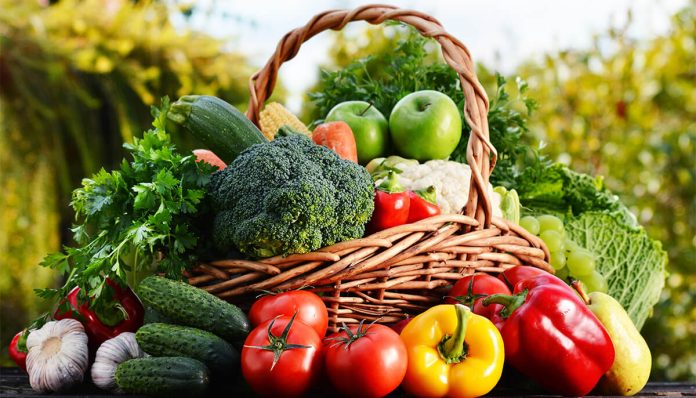All vegetables foods are included in the vegetable food group. There are a variety of different types of vegetables, including:
- dark green, leafy – broccoli, kale, lettuce (dark green, romaine), spinach, watercress
- orange – butternut squash, carrot, pumpkin, sweet potato
- starchy – corn, green peas, potato
- beans & peas – black-eyed peas, borlotti beans, chickpeas (garbanzo), lentils, lima beans, navy beans, red kidney beans, soy beans, tofu (including tempeh), white beans
- cruciferous – brussels sprouts, cabbage, broccoli, cauliflower
- nightshade – capsicum, eggplant, okra, peppers, potato, tomato
- others – artichoke, asparagus, beets, celery cucumber, green beans, mushroom, onion, turnip, snow peas, zucchini
How much of the vegetable food group is needed
The amount of vegetables required each day is dependent on the age and gender of the individual. Vegetables contain high levels of beta-carotene, vitamin C, potassium, phytochemicals and fibre. The recommended daily intake for this food group is dependent on the age and lifestage of the individual.
** these portions are for inactive to moderately active people; for those that are more active, there is scope to have slightly higher portion sizes
| AGE | PORTION | |
|---|---|---|
| CHILDREN | 2-3 years 4-8 years | 1 cup 1.5 cups |
| GIRLS | 9-13 years 14-18 years | 2 cups 2.5 cups |
| BOYS | 9-13 years 14-18 years | 2.5 cups 3 cups |
| WOMEN | 19-30 years 31-50 years 50+ years | 2.5 cups 2.5 cups 2 cups |
| MEN | 19-30 years 31-50 years 50+ years | 3 cups 3 cups 2.5 cups |
| PREGNANT & LACTATING WOMEN | 19-30 years 31-50 years 50+ years | 2.5 cups 2.5 cups 2 cups |
Why the vegetable food group is good for you
The vegetable food group is healthy because of the following important reasons:
- may reduce the incidence of stroke and other heart disease
- may protect against certain cancers of digestive system
- foods high in dietary fibre help reduce HDL (“bad”) cholesterol levels
- contain high amounts of potassium which assists in reducing high blood pressure and water retention
- provide natural sugars for energy sustenance
- should be eaten raw to gain best health benefits (but can be cooked)
- have many vital nutrients essential for good health:
Portion size
Portion sizes for 1 cup (and equivalent) of vegetables are shown below:
| 1 portion (1 cup) | |
|---|---|
| beans & peas | 1 cup (cooked) |
| broccoli | 1 cup chopped or florets 3 stalks & florets (12.5cm long) |
| carrots | 1 cup sliced or diced (cooked or raw) 2 medium |
| corn | 1 cup (cooked) 1 large ear (12.5cm long) |
| cruciferous (cauliflower, cabbage etc) | 1 cup chopped (cooked or raw) |
| cucumbers | 1 cup raw, sliced, chopped |
| leafy greens, spinach | 1 cup sliced or diced (cooked) 2 cups sliced or diced (raw) |
| mushrooms | 1 cup (cooked or raw) |
| peppers, capsicum | 1 cup chopped (cooked or raw) 1 large pepper (8cm long) |
| pumpkin, squash | 1 cup cubed (cooked) |
| snow peas | 3 medium or 2 large 1 cup sliced or diced |
| sweet potato, potato | 1 large baked or boiled 1 cup sliced or mashed (cooked) |
| tomatoes | 8 large berries 1 cup sliced or diced |
| zucchini, squash | 1 cup sliced or diced (cooked) |
High water content
- many vegetables have a high water content and hydrate the body very well, especially when eaten raw
- the vegetables with the highest water content area: lettuce (all types), cucumber, spinach, watercress, capsicum, snow peas, zucchini
Essential nutrients
- an excellent source of Vitamin A / betacarotene, which are effective antioxidants:
- leafy green vegetables – kale, broccoli, spinach
- orange vegetables – carrot, pumpkin, sweet potato
- red vegetables – red cabbage, red pepper
Good source of potassium
- vegetables are a great source of dietary potassium, which is very beneficial in keeping the fluid levels of the body in balance – it reduces water retention
- vegetables are recommended for their high potassium content, which reduces high blood pressure
- potassium is one of the important electrolytes
Good source of energy
- vegetables contains natural sugars to provide a consistent energy, are low in fat and provide a healthy energy source
- are great as a snack in between meals
Amount of dietary fat recommended
- Dietary fat should consist of no more than 30% of total daily calorie intake – which is about 50g-60g of fat for a sedentary person on 7500kJ (1800 calories) a day
Amount of dietary protein recommended
- Dietary protein should consist of no more than 0.75g per kilogram body weight of total daily calorie intake – women who are pregnant should add another 6g of protein and lactating women should add 16-12g of protein per day
Amount of dietary carbohydrate recommended
- Dietary carbohydrate should consist of 45%-65% of total daily calorie intake – it is recommended that these come from unrefined sources with a lower glycemic index


